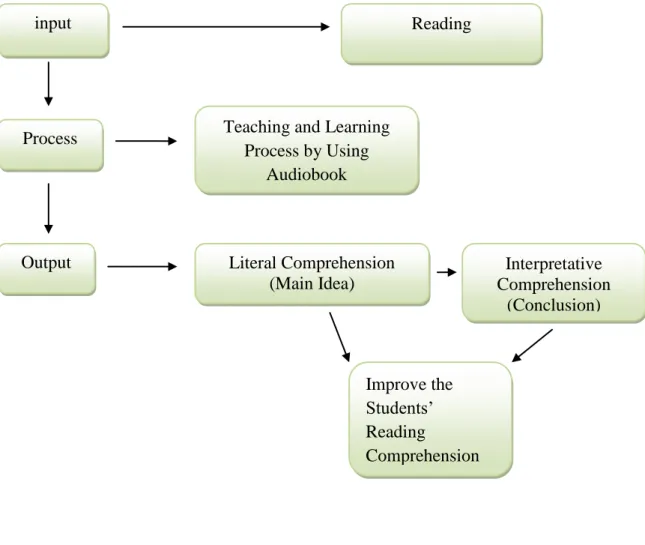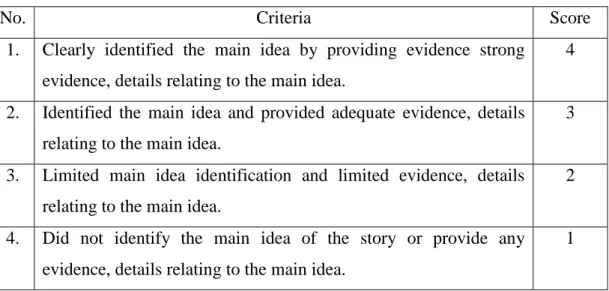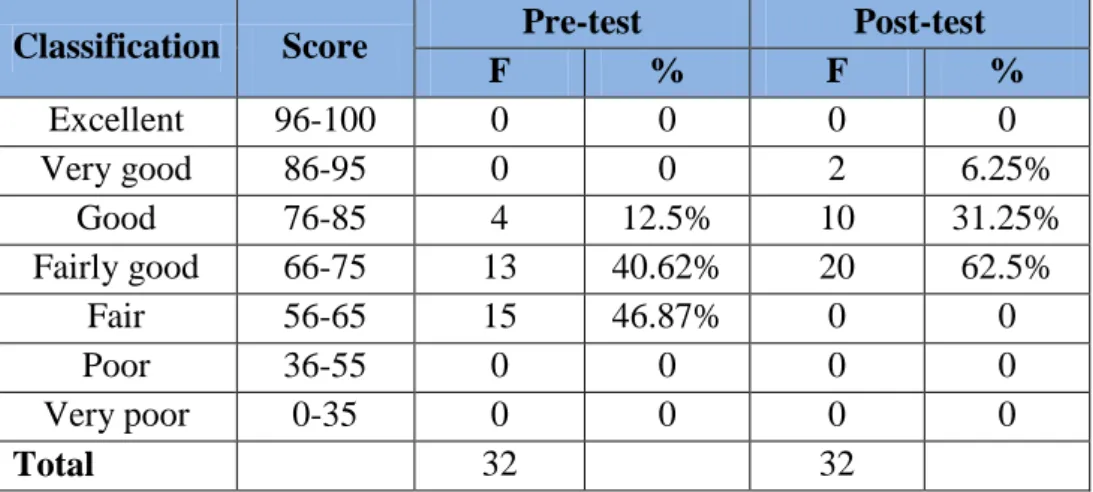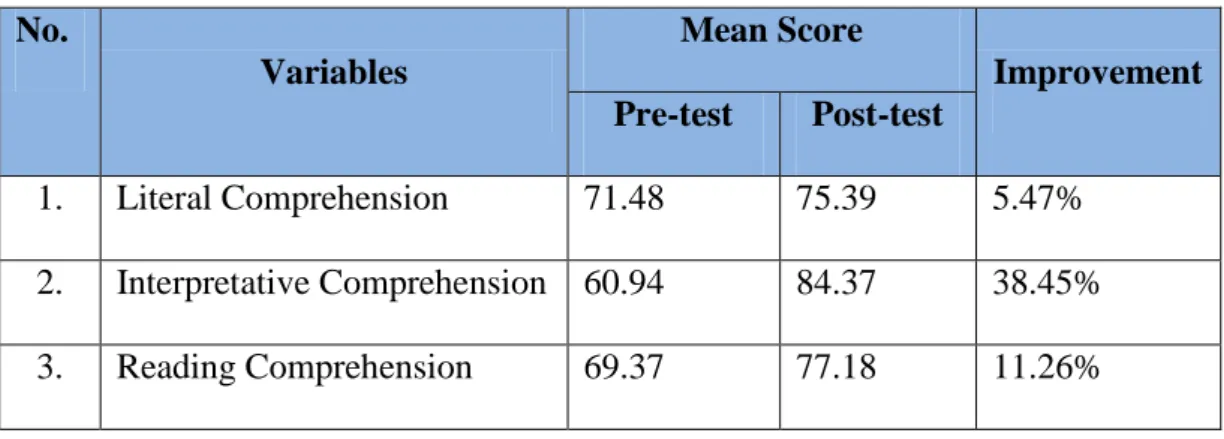Judul Skripsi : Application of Audio Book Media to Build Students' Reading Comprehension (A Pre-Experimental Research on First Year Students of SMA Negeri 3 Bulukumba). Application of audio book media to increase students' reading comprehension (Pre-experimental research on first year students of SMA Negeri 3 Bulukumba) under the thesis of Department of English Education, Faculty of Teacher Training and Education, Muhammadiyah University of Makassar, supervised by Erwin Akib and Nurdevi Bte Abdul. This research aimed to find out the improvement of students' reading comprehension using audio-book media that focused on the level of reading comprehension consisting of literal comprehension and interpretive comprehension.
It was conducted with one class of first year students of SMA Negeri 3 Bulukumba. Based on the analysis of the results, the researcher concluded that the use of audio book media can improve students' reading comprehension. Alhamdulillah Rabbil “Alamin, all glory be to Allah swt, the Lord of the Universe who provided and blessed the researcher until she was able to complete this assignment entitled “Using Audio Book Media to Enhance Reading Comprehension of Early Years Students SMA Negeri 3 Bulukumba”.
Special thanks are given to the Muhammadiyah University of Makassar for providing an opportunity to scholars in obtaining university education. Therefore, the researcher also includes thanks to all the people and occasions that provide the best four-year moment at Muhammadiyah University of Makassar.
INTRODUCTION
- Research Problem
- Research Objective
- Significance of the Research
- Scope of the Research
It is expected that Audiobooks media will make students to describe the story more easily and attract their motivation in reading skill. Based on the explanation, the writer will specify instructional reading using audiobook media. This research is designed to recognize students improved in reading comprehension with the application of audiobook media in the first year of SMA Negeri 3 Bulukumba in Academic Year 2016/2017.
Does the use of audio books build students' literal reading comprehension in the first year of SMA Negeri 3 Bulukumba. Does the use of audio books enhance students' interpretive reading comprehension in the first year of SMA Negeri 3 Bulukumba. To find out the improvement of students' literal comprehension by using audio book media in teaching first year students at SMA Negeri 3 Bulukumba.
To find out the result of applying audio book media to build students' interpretation in reading comprehension of first year students in SMA Negeri 3 Bulukumba. The purpose of this research is limited focused on finding students' improvement in students' literal understanding (main idea), supporting and interpretive details (conclusion) of reading with the application of audiobook media of first year students in SMA Negeri 3 Bulukumba.
REVIEW RELATED LITERATURE
The Concept of Reading
- Definition of Reading
- Techniques in Efficient Reading
- The Aims of Reading
- The Reasons for Reading
Reading is one of the language skills that are very important to develop students' knowledge in their studies. Reading is a tool for learning; students need a range of reading skills to understand textbooks, reference materials, magazines, newspapers, etc. According to Peter Streven, reading is "a skill of great importance to the student because it gives him access to large amounts of additional experience with the language and gives him a window to the normal opportunities to continue his personal education.
It can be said that reading is a process in which the reader receives messages from the authors in writing. From the above quotations it can be concluded that reading is an activity for extracting the information that readers want to extract from the point if it is on a piece of paper in many other media. Skimming is used to quickly gather the most important information, or gist of the text.
It's probably a good idea to create some awareness about the different types of reading skills they naturally use in their own native language before starting this exercise. In most cases, reading for information is relevant to the current research on the reader they read to find information, to reduce their uncertainties.
The Concept of Reading Comprehension
- Definition of Reading Comprehension
- The Level of Reading Comprehension
People read language because they have a desire to do so and a goal to achieve. Taylor states that reading comprehension is an accomplished cognitive process in which readers are aware of and have control over their comprehension. Reading comprehension is a multicomponent, highly complex process that involves many interactions between readers and what they bring to the text (prior knowledge, strategy use) as well as variables related to the text itself (interest in the text, understanding of types of the text).
It relates to what they don't know about information they already know. Literal level comprehension is essential to all reading comprehension at any level because a reader must first. Interpretation, a level of reading that requires a higher level of thinking ability, because the material involved is not directly stated in the text, but only suggested as implied.
Readers are able to answer such a question by simply asking them to remember what the correct words are given in the book. Of course, students who are slow learners will have difficulty working at this level, as well as in the next two categories.
The Concept of Literal and Interpretative Comprehension
- Literal Reading
- Interpretative Reading
Although it requires little or no thinking on the part of readers, it allows them to practice recalling and reproducing statements of fact and has a place in detailed reading of facts. Very often, the writer begins with supporting evidence and places the main idea in the last sentence. Sometimes the writer uses a few sentences to introduce the topic, places the main idea in the middle and follows it with supporting sentences.
The supporting detail question asks the reader to find detail information explicitly printed in the text. It is usually signed with words like: according to the author..; According to the piece..; who, what, when, where, why, how, which. This level requires a higher level of thinking as the questions in the category of interpretation involve answers that are not stated directly in the text, but are suggested or implied where students make connections between individuals' ideas, make inferences, draw conclusions , generalizations and predicting outcomes, reading between the lines to get inferences, or implicitly.
To draw a full conclusion, the reader must read the passage carefully, put ideas and facts together to draw conclusions, and then conclude them by using their experience and intuition. The conclusion should not introduce any new points, but should be related to the thesis or body of the essay.
The Concept of Narrative Text
- The Generic Structure of Narrative text
They may also have learned something and perhaps their opinion has changed from what you wrote or created. The linguistic features of the narrative are the use of processive, temporal, relational verbs and the simple past tense. According to Cooper (1986), like other types of text, narrative text is constructed by overall structure.
Introducing what is in the text, introducing the participants and informing them of the time and place. On the other hand, what text is the conversation in general, who is involved in the text, when and where it happens. Describing the emerging crises that the participant has to deal with what is happening to the participants.
The Concept of Media
- Definition of Media
- Types of Media
However, the researcher chooses audio and videos as the media in the teaching and learning process. The use of audio and videos in the teaching and learning process can be more communicative than long explanations or they can complement the teacher's explanation. Moreover, audio and videos can make students motivated and interested in the teaching and learning process.
The Concept of Audiobooks
- Definition and history of audiobook
- Why use audiobooks
- Advantages of the Audiobooks
- The Implementation of Using Audiobook in the Classroom
Wolfson (2008) has found that this guided reading strategy using audiobooks is akin to reading aloud. He states that “the reading process develops through oral language, and audiobooks in a guided reading program provide another opportunity to increase people's understanding and appreciation. the written word.” Another study by Gilbert, Williams & McLaughlin (1996) shows that reading support has been successfully implemented in children with learning disabilities and second language English speakers. Based on Table 2.1, the study concluded that the final reading comprehension score of students, 4 students (12.5%) were good in the pre-test and then good in the post-test with 10 students (31.25%). The purpose of testing the hypotheses was to find out what the difference is in the students' reading comprehension during the pre-test and the post-test.
Take a few, and your kingdom will never thirst again.” The general broke off a huge piece, loaded it onto his horse cart and hurried back home. Curious, he peered in and exclaimed in astonishment: "Wake up, my worthy men - the waterseed has sprung up." Can we do anything to escape?" "Yes, it is," cried the crow.
As our friend the mouse knows!” Sorbi began to tell everyone what he had seen. I'll stay awake tonight and see who's eating my sugar cane,” the farmer thought to himself.

Concept Framework
- Research Hypothesis
RESEARCH METHOD
Variables and Indicators
- Variables
- Indicators
Population and Sample
- Population
- Sample
The total number of the population in this research was 212 students, which is divided into nine classes. In selecting the sample, the researcher in this research used purposive sampling in selecting the classes of the population that will become the experimental class. Purposive sampling was used in this research, the researcher takes a sample for students who only have a laptop or mobile phone because the researcher wanted to know.
Research Instrument
The data analysis shows that the average score of the students improved from pre-test to post-test. The data analysis shows that the average score of the students improved from pre-test to post-test. The data analysis shows that the average score of the students has improved from pre-test to post-test.
The average score of the students during the pre-test was 69.37 and after applying the treatment, the students' reading comprehension improved. Therefore, the use of audiobooks could improve the students' reading comprehension in the first year of SMAN 3 Bulukumba. Applying Audiobook Media more significantly improved students' reading comprehension among the first-year students of SMAN 3 Bulukumba.








